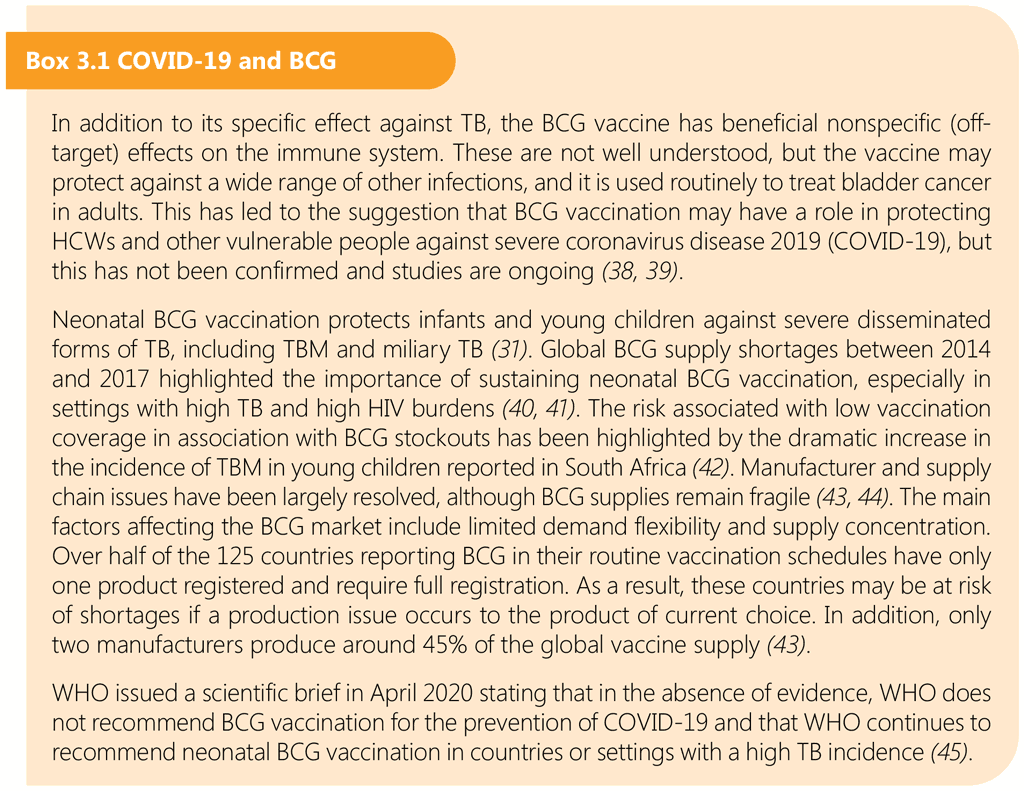Book traversal links for 3.2.1.4. Adverse reactions
BCG vaccine is used extensively worldwide, with about 100 million newborns vaccinated each year. Severe adverse events are reported only occasionally. For some adverse events (e.g. disseminated BCG disease), the diagnosis may depend on the culturing of M. bovis BCG to distinguish it from other forms of mycobacterial disease (33). It is important to recognize that M. bovis BCG has a positive result when tested with Xpert® MTB/RIF (Cepheid, Sunnyvale, United States of America) or Ultra (see Chapter 4). It should be considered as the likely cause of a hilar lymph node mass (which is positive on Xpert) on the same side as the BCG vaccination in a child who has recently received BCG and is otherwise clinically well.
Mild adverse events
After BCG vaccination, almost all children experience an injection site reaction characterized by a papule, which may be red, tender and indurated. The papule commences 2 weeks or more after vaccination and may progress to an ulcer that heals after 2–5 months, leaving a superficial scar. Swelling of the regional lymph nodes on the same site as the injection (usually axillary but also cervical and do not adhere to overlying skin. Ulcers should be left to heal on their own and not manipulated.
Mild local reactions may happen despite correct intradermal administration. The extent of the reaction depends on a number of factors, including the strain used in the vaccine, the number of viable bacilli in the batch, and variation in injection technique. No treatment is required for mild injection site reactions with or without mild regional lymphadenopathy. If required, analgesics such as paracetamol can be provided.
Severe adverse events
Severe adverse events can occur after BCG vaccination, but they are rare.
Severe local adverse events include:
- injection site reactions, such as local subcutaneous abscess and keloids (thickened scar tissue);
- skin lesions distinct from the vaccination site – multiple cutaneous lesions may be a sign of disseminated BCG disease in an immunocompromised host;
- BCG lymphadenitis – in severe forms, lymph nodes may become adherent to overlying skin with or without suppuration (fluctuation on palpation or pus on aspiration, a sinus, or a large lymph node adherent to the skin with caseous lesions on excision). This usually affects ipsilateral axillary lymph nodes, but supraclavicular or cervical nodes may also be involved. Lymph node aspirates may be positive on Xpert MTB/RIF or Ultra.
Severe systemic adverse events include systemic or disseminated BCG disease in which M. bovis BCG is confirmed in one or more anatomical sites far from the site of injection and regional lymph nodes (34). Disseminated BCG disease or systemic BCG-itis is associated with a case fatality rate of over 70% in infants living with HIV. It may clinically present very similarly to TB and can be confirmed only through positive mycobacterial culture with species identification. Symptoms include wasting or failure to thrive, anaemia, hepatosplenomegaly, lymphadenitis (axillary, cervical), osteomyelitis and CXR infiltrates.
Immune reconstitution inflammatory syndrome (IRIS) is a BCG vaccine-related adverse event seen in immunocompromised people living with HIV who are started on ART. It usually develops within 3 months of immune recovery and presents as local abscesses or regional lymphadenitis, usually without dissemination. Early initiation of ART before immunological and/or clinical HIV progression has been shown to substantially reduce the risk of BCG IRIS regional adenitis.
Other rare events include osteitis, osteomyelitis, sarcoidosis, ocular lesions (conjunctivitis, choroiditis, optic neuritis), erythema nodosum and meningitis (exceptionally rarely).
Management of severe adverse events
In many cases, local and regional adverse events resolve without intervention, but treatment can include oral antibiotics (BCG is resistant to pyrazinamide, and some strains are partially resistant to isoniazid), needle aspiration of fluctuant masses, and surgical removal of affected lymph nodes, along with analgesics such as paracetamol. A systematic review conducted in 2013 found no evidence of any benefit of using oral antibiotics to treat local or regional BCG-induced disease. In people with abscess-forming lymphadenopathy, needle aspiration of abscesses provides pain relief (35).
Children with systemic adverse events require referral to specialized care. There are no clear guidelines on treatment of disseminated BCG disease, but management usually includes isoniazid, rifampicin and ethambutol (with or without a fluoroquinolone such as levofloxacin) (36). Surgical intervention may be needed, depending on localization (37).

 Feedback
Feedback